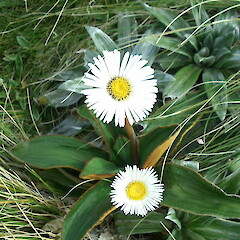Celmisia traversii
Common name
mountain daisy
Synonyms
Celmisia praestans Allan
Family
Asteraceae
Flora category
Vascular – Native
Endemic taxon
Yes
Endemic genus
No
Endemic family
No
Structural class
Herbs - Dicotyledonous composites
NVS code
The National Vegetation Survey (NVS) Databank is a physical archive and electronic databank containing records of over 94,000 vegetation survey plots - including data from over 19,000 permanent plots. NVS maintains a standard set of species code abbreviations that correspond to standard scientific plant names from the Ngä Tipu o Aotearoa - New Zealand Plants database.
CELTRA
Chromosome number
2n = 108
Current conservation status
The conservation status of all known New Zealand vascular plant taxa at the rank of species and below were reassessed in 2017 using the New Zealand Threat Classification System (NZTCS) – more information about this can be found on the NZTCS website. This report includes a statistical summary and brief notes on changes since 2012 and replaces all previous NZTCS lists for vascular plants.
Please note, threat classifications are often suggested by authors when publications fall between NZTCS assessment periods – an interim threat classification status has not been assessed by the NZTCS panel.
- Conservation status of New Zealand indigenous vascular plants, 2017 . 2018. Peter J. de Lange, Jeremy R. Rolfe, John W. Barkla, Shannel P. Courtney, Paul D. Champion, Leon R. Perrie, Sarah M. Beadel, Kerry A. Ford, Ilse Breitwieser, Ines Schönberger, Rowan Hindmarsh-Walls, Peter B. Heenan and Kate Ladley. Department of Conservation. Source: NZTCS and licensed by DOC for reuse under the Creative Commons Attribution 4.0 International licence.
2017 | Not Threatened
Previous conservation statuses
2012 | Not Threatened
2009 | Not Threatened
2004 | Not Threatened
Distribution
Endemic. New Zealand: South Island (Tasman Mountains as far south as the Wangapeka Saddle; along the main divide from St Arnaud Range to about Doubtful Valley; scattered populations in mountains south of Wairau Valley to Hanmer; Shale Peak, Canterbury; eastern Fiordland from Key Summit to the Hump and Cameron mountains; Mararoa Valley; Takitimu Mountains).
Habitat
Montane to alpine. Mostly in tussockland and rocky herbfield, especially south facing. In inland Marlborough it occurs on shaded bluffs in the headwaters of major rivers.
Detailed description
Woody-based herb with short branchlets arising from a multicipital stock, usually just below the soil surface; living leaves in rosettes at the tips of branchlets; the whole plant forming a clump of few to many rosettes. Leaf sheaths densely imbricate and compacted into pseudostem. Leaf lamina 50–300 × 15–90 mm, coriaceous, at first erect but later decumbent, lanceolate, elliptic, oblong to sometimes oblanceolate; upper surface often sulcate, concolorous, deep green, glabrous or with whitish hairs especially along the midrib; lower surface densely clad with thick ferrugineous or deep buff tomentum; tip acute, margins entire, rimmed with ferrugineous hairs; base obliquely cuneate or truncate; petiole usually short, sometimes up to ⅓–⅔ lamina length, purple, often clad in floccose whitish hairs. Scape purple, clad in buff or ferrugineous tomentum, up to 300 mm long; bracts numerous, erect, linear; monocephalous. Capitula up to 60 mm diameter. Involucral bracts in several series, linear-subulate, erect, clad throughout with brown tomentum. Ray florets c. 75, ligulate, the limb linear-lanceolate, white. Disc florets c. 160, funneliform, yellow; tube with eglandular, biseriate hairs. Achene fusiform cylindric, strongly ribbed, 5 mm long, glabrous. Pappus unequal 6–7 mm long, of c. 30 bristles.
Similar taxa
Distinguished from the closely related, allopatric Celmisia cordatifolia by the leaf blade which is cuneate to truncate, rarely < 100 mm long, and by the brown-tomentose involucral bracts.
Flowering
November–March
Flower colours
White, Yellow
Fruiting
December–May
Life cycle
Pappate cypselae are dispersed by wind (Thorsen et al., 2009).
Propagation technique
One of the few Celmisia that is easily grown in most climates though it dislikes high humidity. Best grown in a moist, free draining soil, within some afternoon shade. Plants can be raised from division but are best grown from fresh seed.
Etymology
celmisia: Apparently named after Kelmis, one of Idaean Dactyls, a group of skilled mythical beings associated with the Mother Goddess Rhea in Greek mythology. Kelmis, whose name means ‘casting’, was a blacksmith and childhood friend of Zeus, son of Rhea and later king of the gods. In Ovid’s ‘Metamorphoses’, Kelmis is described as offending Zeus who turned him into adamant so he was as hard as a tempered blade
traversii: Named after William Thomas Locke Travers (1819-1903) who was an Irish lawyer, magistrate, politician, explorer, naturalist, photographer. He lived in New Zealand from 1849 and was a fellow of the Linnean Society.
Where To Buy
Occasionaly available from specialist native plant nurseries.
Attribution
Description based on Given (1984)
References and further reading
Given DR. 1984. A taxonomic revision of Celmisia subgenus Pelliculatae section Petiolatae (Compositae—Astereae). New Zealand Journal of Botany 22(1): 139–158. https://doi.org/10.1080/0028825X.1984.10425241.
Thorsen MJ, Dickinson KJM, Seddon PJ. 2009. Seed dispersal systems in the New Zealand flora. Perspectives in Plant Ecology, Evolution and Systematics 11: 285–309. https://doi.org/10.1016/j.ppees.2009.06.001.







